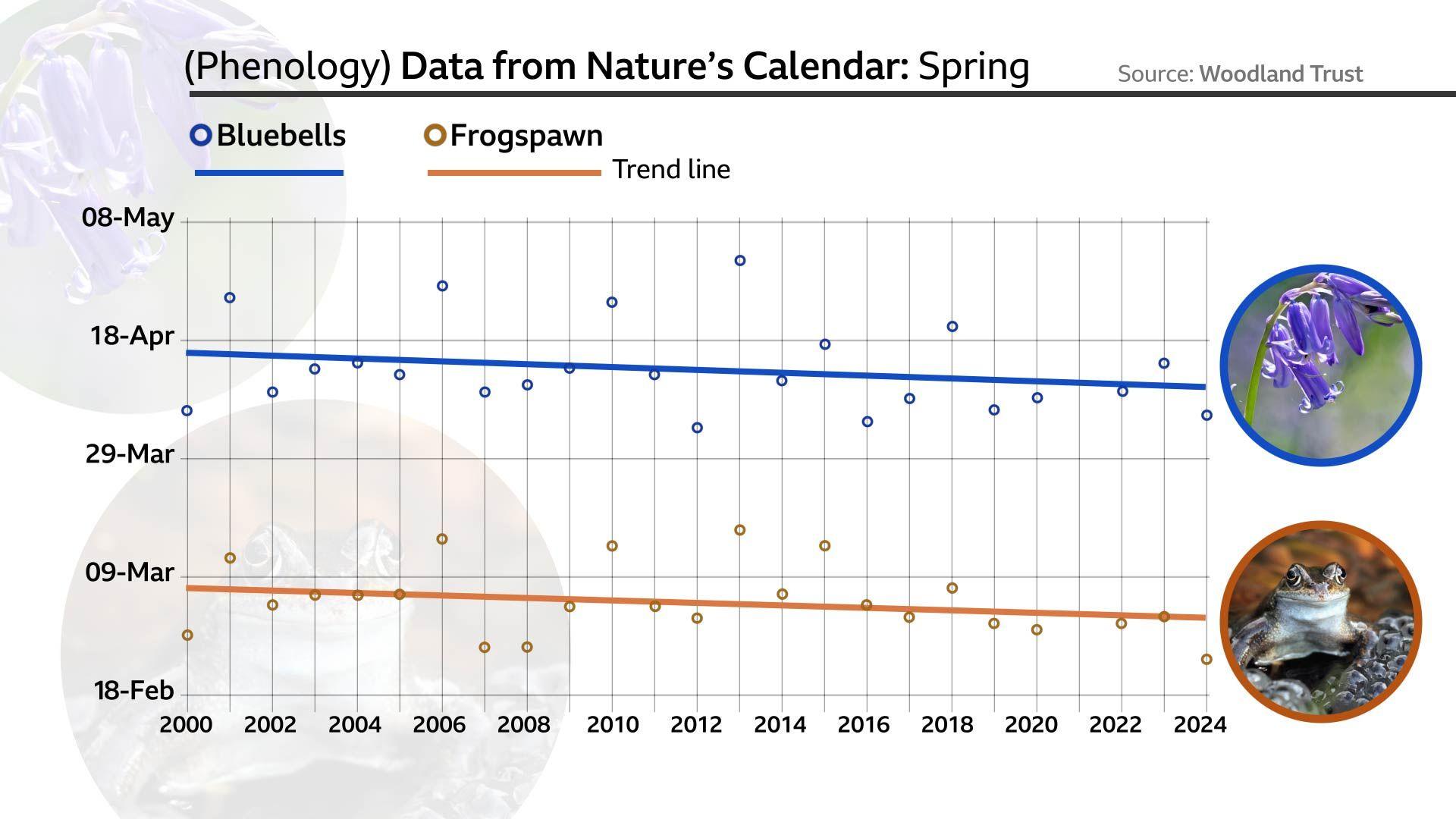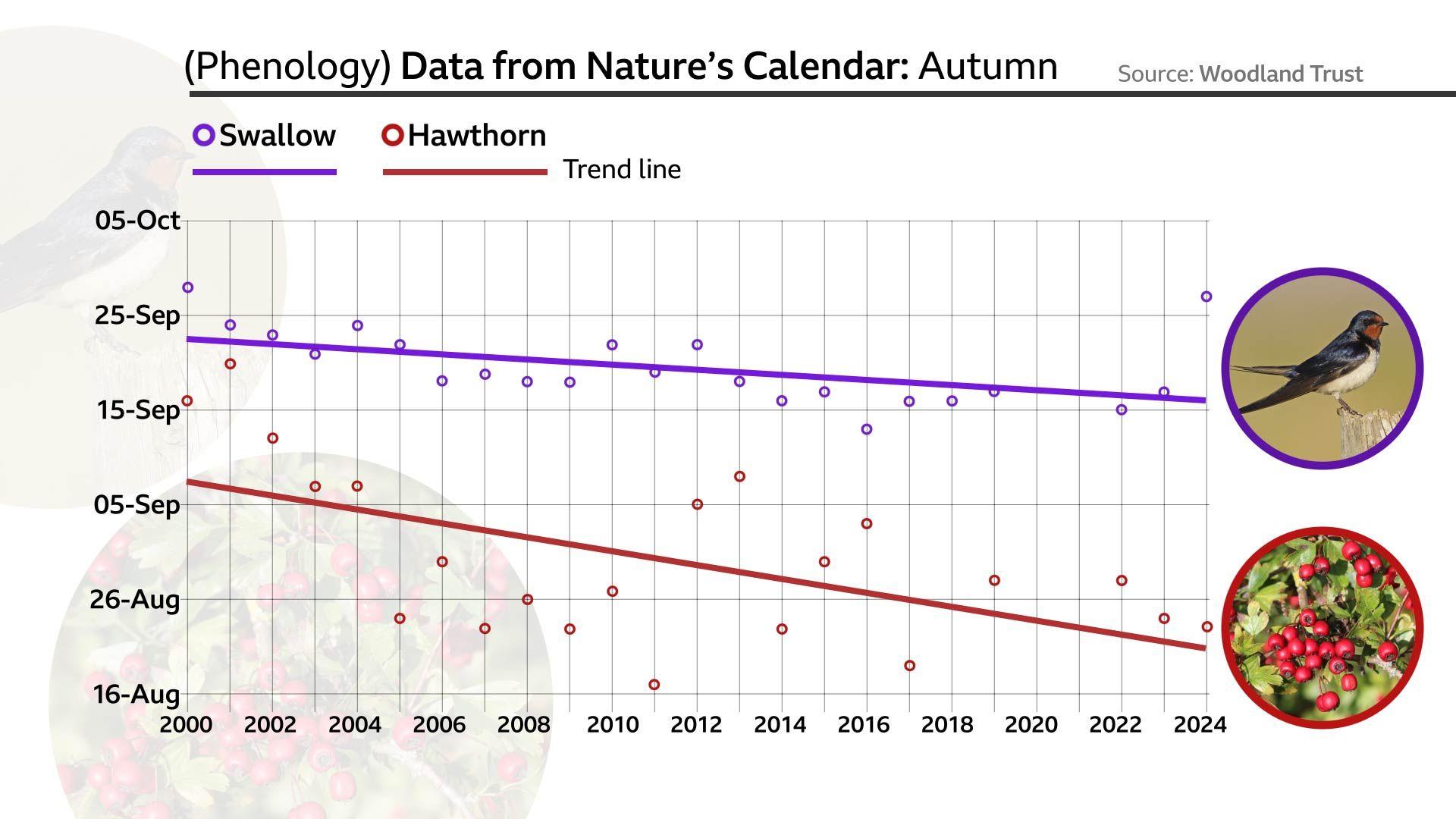Climate change tricking UK seasons
Climate change tricking UK seasons
Species in the United Kingdom are under threat as they are "tricked" by our seasons shifting with the changing climate.
On average, key events that herald the start of spring are happening nine days earlier than a quarter of a century ago.
Data given to BBC Weather by Nature's Calendar - a citizen science project by the Woodland Trust - shows how warming is triggering events associated with the changing seasons to happen earlier in the year.
In 2024, frogspawn appeared at its earliest date on record, 17 days before the average date or benchmark.
Definition of seasons
Seasons are defined in three different ways.
Meteorological - fixed every year to ensure statistics are consistent throughout time. Spring in the northern hemisphere starts on 1 March and autumn on 1 September.
Astronomical - follows the equinox and can vary slightly each year. Spring falls between 19-23 March and autumn 22-24 September.
Phenological - follows biological events and their response to weather and climate
While meteorological and astronomical seasons are known in advance, the way nature behaves in each season is dependent on the weather and climate.
Since 2000, the Woodland Trust has been gathering data via Nature's Calendar which uses public sightings of plants, animals and fungi to track the effects of weather and climate on nature.
Alex Marshall from Nature's Calendar explained how important the data is to "see how nature is responding to our changing climate".
The data is used by the Met Office in its annual State of the UK Climate report, comparing meteorological data with biological events and their response to weather and climate (phenology).
Sightings of bluebells and frogspawn have been getting earlier in spring since 2000
Spring changes
Looking at the data for when bluebells and frogspawn start to appear in the spring shows some clear trends over nearly three decades.
Both are appearing earlier in April and March respectively.
In 2024 we had a relatively mild January followed by the second warmest February on record.
Ms Marshall said: "In general, spring is getting earlier due to higher temperatures, particularly at the start of the season."
"Warmer weather at the end of winter tricks species like the frog into thinking it's time to start reproducing.
"That becomes a problem, though, if some early March frosts occur which can kill the developing tadpoles...one negative impact of them coming out a bit early."
The other consideration is the interconnecting food chain.
If some species respond earlier than others, food resources they expect may not be as available.
Met Office analysis of data from 2023 showed that for every one degree Celsius increase in temperature in the few months before the benchmark date, spring responses were one to seven days earlier.
Hawthorn berries and last swallow departure sightings in the UK have been getting earlier in autumn
Mixed autumn responses
What occurs in the autumn is a little more complicated and may be down to knock-on effects from the spring.
Data provided by Nature's Calendar on when swallows migrate for the winter and hawthorn berries first ripe show an earlier trend in the year.
Since 2000 hawthorn berries have, on average, appeared 17 days earlier and more likely in late August than September.
But as Ms Marshall explained: "There is a complication with the time frame from when a flower is pollinated to a berry being ripe as we don't know how or if this is changing over time."
Swallows tend to start migrating when their food supplies begin to run low.
And their main food source is flying insects which are less abundant during wet weather.
If our autumns get wetter then that would suggest swallows leave earlier.
Though Ms Marshall points out that this year, swallows migrated eight days later than the benchmark, even after a very wet September, so it is hard to say exactly what is going on.
Met Office analysis suggests for every 1C increase in October temperature, the date at which trees lose all their leaves is delayed by about two or three days.
Extreme weather has consequences
From all the data gathered by Nature's Calendar, there are clear trends to changing timescales in our phenology.
Climate change will bring higher temperatures but also more extreme weather leading to confusion amongst some species.
"It's the unpredictability which is the biggest threat at the moment," says Ms Marshall.
With each tree, flower, fruit or animal species reacting slightly differently to our changing climate, there may become a mismatch of events.
This could lead to a disruption in the food chain to some of our species and put them under pressure in the future.



대화 참여하기